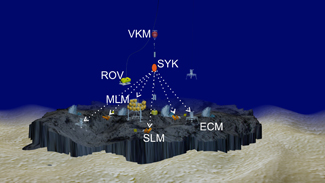Diving deep: researchers place a new ocean observatory on the sea floor
 Studying the ocean is hard. It’s vast, deep, and not that friendly on the stomach. And once you’re in, you can’t stay for long - scientists using submarines can only stay down for a few hours at a time. And research submarines are expensive to use.
Studying the ocean is hard. It’s vast, deep, and not that friendly on the stomach. And once you’re in, you can’t stay for long - scientists using submarines can only stay down for a few hours at a time. And research submarines are expensive to use.One solution to that problem is to simply move the lab into the ocean. Which is just what these scientists did. They’re about to deploy an ocean lab to gather data continuously at the sea floor.
This particular ocean lab - called MoLab - will monitor sea conditions for several months. The station set off to be installed on the 26th of may, and is headed for a cold water reef, near Norway, and will study what’s going on within a few square kilometers of home base. “We want to find out why the corals grow at this specific place and what the impact of climate change on the corals will be “, Dr Olaf Pfannkuche, chief scientist of the cruise that will send MoLab down, said in the press release.
 The lab has a few key parts, all labeled in the image to the left. The center segment of the lab is the communication center. That sends signals out to all the different parts of the system, and up to scientists on dry land who are monitoring the lab. Other parts will go out and collect data on the biological, physical, chemical and geological goings on of the reef. This is cool because with many submarine dives, researchers have to be very selective about what data they can collect. “No process in the ocean stands alone. The topography of the ocean floor influences currents, currents influence the distribution of nutrients and thus biology, organisms build up the ocean floor anew after their deaths. If we want to make progress in research about global change we have to consider all these multiple interactions”, said Pfannkuche in the press release.
The lab has a few key parts, all labeled in the image to the left. The center segment of the lab is the communication center. That sends signals out to all the different parts of the system, and up to scientists on dry land who are monitoring the lab. Other parts will go out and collect data on the biological, physical, chemical and geological goings on of the reef. This is cool because with many submarine dives, researchers have to be very selective about what data they can collect. “No process in the ocean stands alone. The topography of the ocean floor influences currents, currents influence the distribution of nutrients and thus biology, organisms build up the ocean floor anew after their deaths. If we want to make progress in research about global change we have to consider all these multiple interactions”, said Pfannkuche in the press release.MoLab is mostly autonomous. It has different pieces that monitor all sorts of things, but there are no humans down there. The idea is to send the lab down, set it and forget it. Well, forget it until the data come back at least.
You can return to the main Market News page, or press the Back button on your browser.

